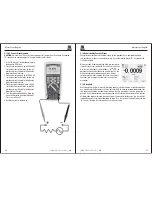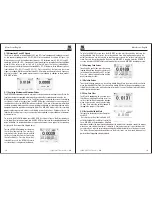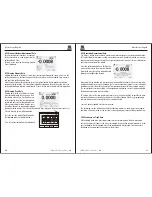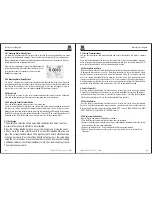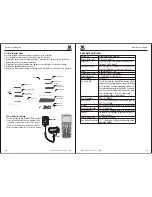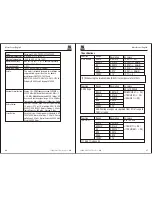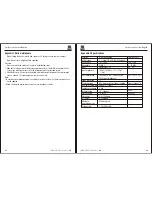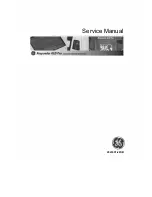
13/08/2017 Version No. 001
Oscilloscope Section/English
Oscilloscope Section/English
13/08/2017 Version No. 001
41
40
If adopt FFT (Fast Fourier Transform) mode, take following steps:
1. Set up time domain waveform
•
Press “AUTO” to display proper waveform.
•
If displayed waveform shows unsatisfactory, press
“
” and “
” for adjustment.
•
Press F4 (FFT), the oscilloscope may adopt the 256
central points of time domain waveform to calculate
FFT frequency spectrum.
•
According to Nyquist criterion, press “
”, make
sampling rate up to at least 2 times of input signal
frequency.
2. FFT frequency spectrum display
Press “F4” FFT button, display FFT frequency spectrum, in which a channel waveform
and FFT waveform are shown in the split screen.
FFT windows instructions
As the oscilloscope takes FFT transform for time
records of limited length, FFT calculation mode bases
on repeated YT waveform. In this case, if the cycle is
integer, frequency values of YT waveform are the same
at the beginning and the end, the waveform may not be
interrupted. However, if the YT waveform cycle is not
integer, frequency values shows different at the beginning
and the end, high-frequency transient interrupts occur at
connecting part. That is so-called “leakage” in frequency
domain. Therefore, in order to avoid leakage, multiply
a window function with the original waveform, forcing
the values at the beginning and the end to 0.
3. Position FFT frequency spectrum
•“
” button can still be pressed under FFT interface to change sampling rate, to realize
horizontal amplification or minification;
•Adjust “
” to realize vertical amplification or minification.
4. Measure FFT frequency spectrum by cursor
•T
wo kinds of measurement can be taken for FFT spectrum by using cursor: amplitude
(relative value) and frequency (unit: Hz).
•Under FF
T interface, press F2 (
) or F3 (
) according to prompt bar to move red
cursor, corresponding frequency and relative amplitude can be measured
.
Picture 2-10-1(split screen)
Picture2-10-2
Note:
•
DC component or deviation existed in signal may cause error or deviation in FFT waveform
component part. Select DC coupling mode to reduce AC component.
•
Nyquist frequency: for waveform, of which highest value ups to F, sampling rate of 2F must
be adopted to rebuild the waveform, that is also called Nyquist criteria, “F” means Nyquist
frequency, “2F” means Nyquist rate.
2 11 Signal Capture System
•R
eal-time sampling: the memory space should be full for every sampling.
R
eal-time sampling
rate ups to 50MSa/s.
•The system is under default continuous sampling state af
ter startup, press “HOLD” if user
wants to take static measurement, press the same button again to turn back to continuous
sampling state.
•“REC
” button: if the user needs the oscilloscope to take sample of enough data to analyze
a series of numbers, press “REC
”, the oscilloscope may continuously take data sample of
10 pages for measurement analysis.
•Time base: the oscilloscope takes sample of input signal value
s at discontinuous points to
digitalize the waveform. Frequency of value digitalization can be controlled by adopting time
base. Press “
”, adjust the time base to a horizontal level to satisfy user’s needs,
•F
alse wave phenomenon: if the speed of sampling is not fast enough, causing inaccurate
waveform records, “false wave phenomenon” occur. In this case, the oscilloscope displays
the waveform by a frequency which is below actual input waveform’s frequency, or triggers
and displays unstable waveform. Therefore, press “AUTO” to auto search for the first
measurement of new signal, to confirm the basic frequency of this signal.
-
False wave phenomenon
actual high
frequency waveform
sampling point
low frequency
waveform caused by
false wave phenomenon



